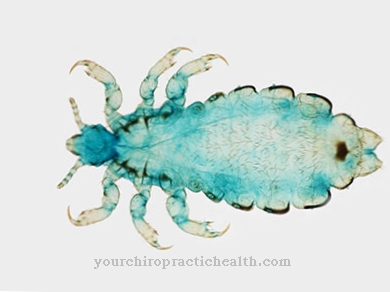In the Hyperpigmentation pigment spots appear on individual parts of the body or all over the body. These stains have no health effects, but can be perceived as unaesthetic. In particular, direct sunlight should be avoided to prevent and treat hyperpigmentation.
What is hyperpigmentation?

© Jet Cat Studio - stock.adobe.com
Hyperpigmentation, also as Chloasma or Melasma known, occurs as pigment spots, the color of which is darker than the actual skin color. The color scale can differ from brown tones to red and yellow tones. The affected areas of hyperpigmentation are flat and cannot be felt. In medicine, a distinction is made between different types of hyperpigmentation, in which pigment spots arise due to different causes.
With hyperpigmentation, too much melanin is stored in the skin. The pigments are either formed by the body itself or externally, e.g. medication or cosmetics. Hyperpigmentation is often only temporary, so that the pigment spots fade completely or partially again after a few months or years.
Hyperpigmentation is generally not a health hazard.
causes
The Hyperpigmentation can have various causes and occur localized or generalized. In localized hyperpigmentation, the pigment spots only appear on specific and limited parts of the body. In generalized hyperpigmentation, the pigment spots appear all over the body.
Hyperpigmentation can be triggered, among other things, by pregnancy hormones. The pigment spots appear in the area of the nipples, abdomen and genitals and in many cases fade after childbirth or the end of breastfeeding.
Hyperpigmentation can also be caused by diseases and inflammations, as well as by the supply of pigments from drugs, cosmetics or tattoo ink. Hyperpigmentation often occurs in connection with excessive natural or artificial UV radiation. Long-term mechanical pressure or friction can also lead to localized hyperpigmentation. Sunlight also promotes the darkening of existing pigment spots.
Symptoms, ailments & signs
Hyperpigmentation results in heavily pigmented spots on the skin. These pigment disorders are localized and occur in one or more places. In individual cases the entire skin is affected by hyperpigmentation. Depending on the form, further symptoms can appear.
Freckles are manifested, for example, by the fact that the pigment spots only appear on the areas exposed to sunlight. They are small, round, and appear in large groups on the face, shoulders, and neck. Lens spots are larger and darker and can appear all over the body. Hyperpigmentation is usually harmless.
Usually only external changes occur, which recede after a while or remain symptom-free. However, hyperpigmentation can be emotionally stressful for those affected. Especially with extensive skin changes, inferiority complexes, social fears or depressive moods arise again and again.
The hyperpigmentation can cause further skin changes under certain circumstances. A permanent pigment disorder can develop in the affected skin area, which manifests itself in the fact that the skin area is no longer influenced by UV radiation. In general, however, hyperpigmentation is harmless and does not cause serious symptoms or discomfort.
Diagnosis & course
The localized Hyperpigmentation is noticeable through gray-brown, reddish or yellowish, darker skin areas. The pigment spots are usually clearly delineated and appear symmetrically only on individual parts of the body. If the hyperpigmentation is hormonal, pigmentation occurs mainly on the face and neck as well as around the nipples and in the genital area. If there are already cases of hyperpigmentation in the family, a hereditary pigment disorder is likely.
The development of hyperpigmentation can vary widely and depends on the type and severity of the disorder. Hyperpigmentation caused by pregnancy hormones subsides in two thirds of those affected after the end of pregnancy or breastfeeding and the pigment spots fade within a few weeks.
In the case of hyperpigmentation, which is caused by the supply of pigments through drugs, cosmetics or other external factors, avoiding the causative factors can cause the pigment spots to disappear after a few months.
Complications
As a rule, the hyperpigmentation does not have any negative health effects on the patient. There are no further complaints or pain, so that the hyperpigmentation does not necessarily have to be treated. The spots can develop either all over the body or only in certain areas. As a rule, it cannot be predicted whether and when a particular region will be affected by the disease.
Due to the high sensitivity of the skin, the person concerned has to avoid direct sunlight and is thereby restricted in his everyday life. It is not uncommon for hyperpigmentation to lead to psychological complaints and depression. Most patients feel ashamed of the disease and suffer from inferiority complexes and decreased self-esteem.
However, the hyperpigmentation has no effects on the health of the person affected, so that life expectancy is not restricted by this disease. In some cases, the patient also heals spontaneously from the disease. Treatment can usually not be carried out. The symptoms of hyperpigmentation can, however, be limited with cosmetic agents. It can happen that the patient does not tolerate a certain ingredient and has an allergic reaction to it.
When should you go to the doctor?
If unusual pigment spots are noticed in individual areas of the body, it may be hyperpigmentation. The spots usually do not require any treatment and often disappear on their own after a while. Anyone who perceives these spots as aesthetic flaws should consult a dermatologist. Medical clarification is also useful if there are any side effects. A doctor should be consulted if the spots become infected or cause pain.
If the skin spots increase after contact with direct sunlight, the dermatologist must also be consulted. The skin is particularly sensitive in the relevant areas, which is why precautionary measures must be taken in any case. Therefore, if you suspect hyperpigmentation, you should consult a specialist. If the spots cause emotional problems, the doctor can put you in touch with a therapist.If it is suspected that the skin changes are triggered by a certain drug, the doctor should be discussed about changing the medication.
Doctors & therapists in your area
Treatment & Therapy
Even if one Hyperpigmentation does not pose a health risk, the dark pigment spots are often perceived as unaesthetic and annoying. There are various treatment options available to lighten the affected areas.
Local application of bleaching creams or chemical peelings should be avoided, as these attack the skin very severely and thus in some cases cause the pigment spots to become even darker or, if the dosage is too high, result in scarring.
Severe hyperpigmentation can be treated with modern laser procedures that specifically destroy only the pigmented skin. Treatment with a Fraxel laser or a thulium laser are particularly suitable. With laser treatment, however, there is still the risk that light or white spots will remain in place of the dark pigment spots. The gentlest treatment for hyperpigmentation is the use of special cosmetics that lighten and reduce pigment spots with natural agents such as yeast extracts and vitamin derivatives.
The basis of any treatment for hyperpigmentation is in any case to avoid exposure to the natural sun and solarium. UV rays can very quickly darken pigment spots and, if you are not careful, you can reverse treatment progress in a short time.
Outlook & forecast
Over the course of life, hyperpigmentation leads to a constant increase in changes in the appearance of the skin. Normally, however, there is no need for action, since from a medical point of view there is no illness in the patient. Rather, it is a visual flaw that has no effect on the physical condition of the person concerned.
However, if the pigmentation changes, the prognosis worsens. In these cases there is a development of a disease for which there is a need for timely treatment and therapy. The future prospects must be assessed individually and based on the underlying disease. The later a doctor is consulted, the higher the risk of a malignant and thus potentially life-threatening illness.
If the person concerned is mentally or emotionally stressed due to hyperpigmentation, the risk of side effects or the development of secondary diseases increases. Feelings of inferiority, fear, shame or withdrawal from social life can occur and contribute to a deterioration in general well-being.
In severe cases, the patient is threatened with mental disorders. Without medical care or psychotherapeutic treatment, far-reaching problems can arise. Although there are no physical impairments, the psychological disorder caused by hyperpigmentation can lead to severe, life-impairing disorders that endanger the patient's general state of health.
prevention
The most efficient prevention of Hyperpigmentation is avoiding direct sunlight by covering the affected parts of the body or using creams and care products with a sun protection factor. If hyperpigmentation has already occurred, special creams and cosmetic treatments can prevent the pigment spots from spreading further or becoming more visible.
Aftercare
In most cases, there are no special follow-up measures available to those affected with hyperpigmentation. They are not always necessary, as hyperpigmentation does not always have to be treated immediately by a doctor. Nevertheless, it is advisable to consult a doctor with this disease so that there are no further complaints or complications on the skin of the person concerned.
As a rule, the life expectancy of the person affected is not reduced or otherwise restricted by this disease. In many cases, the patients are dependent on psychological treatment. Children in particular often need the support of their parents so that there are no psychological upsets or depression.
In the case of scars, a correction can also be carried out in order to improve the aesthetics of the person affected. Furthermore, in the event of hyperpigmentation, the patient should protect himself from direct sunlight and avoid it.
Sufficient sun protection should always be used when sunbathing so that there are no complications. Contact with other affected persons can also be very useful in the case of hyperpigmentation, as this often leads to an exchange of information that can make life easier for the person affected.
You can do that yourself
Usually no treatment is necessary for hyperpigmentation. Self-help measures are also not absolutely necessary for this disease. However, further complications and complaints can be prevented relatively easily.
In the case of hyperpigmentation, the person affected should avoid direct sunlight in any case and always wear sun protection when in the sun. Children in particular need to be informed about the risks of direct sunlight. The irritated skin can be soothed by using different creams or ointments. This may also prevent the formation of scars. When using cosmetic products, the patient should always make sure that the cosmetics are based on natural ingredients. During a long stay in the sun, the patient should protect all parts of the body from the sun.
Hyperpigmentation can also lead to psychological complaints. Enlightening discussions with other affected persons or with your own partner and family are very helpful. In severe cases, however, a therapist should be sought, as hyperpigmentation can lead to bullying or teasing in children.


.jpg)

.jpg)








.jpg)

.jpg)
.jpg)











.jpg)